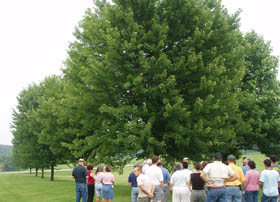Home > Tree structure basics > Structural defects > Cracks and splits > More on cracks
More on trunk cracks
A slight depression with bark peeling off can indicate a crack inside. |
|

The cracks and inclusions formed at the base of the trunk in redcedars,
arborvitae, laurel oak, and other trees occur naturally. This photo
shows that the inclusions can extend quite a ways into the trunk. Trees
like this can live for a very long time. This tree was 375 years old
when it was cut.
 Cracks can originate from dry soil conditions. These cracks were caused by drought conditions following planting of this 6 inch diameter red maple. The top of the tree was obviously stressed with dropping foliage and dead twigs; however, regular irrigation improved vigor and the tree recovered. These cracks will not go away but they will be covered over with new trunk growth in the next few years.
Cracks can originate from dry soil conditions. These cracks were caused by drought conditions following planting of this 6 inch diameter red maple. The top of the tree was obviously stressed with dropping foliage and dead twigs; however, regular irrigation improved vigor and the tree recovered. These cracks will not go away but they will be covered over with new trunk growth in the next few years.
Each of the maples in this row was damaged several years ago when trunks split on a cold winter night. Damage is shown on the right. Some call these frost cracks. |
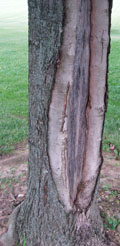 |
 Cracked bark likely caused by lack of soil moisture. |
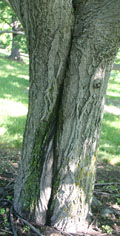 Cracked trunk from a bark inclusion at the very top of the photo. |
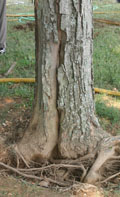 Cracked trunk originating from a severe root defect (stem girdling root) underground. |
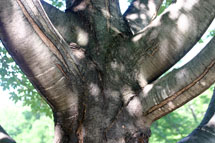 Natural growth expansion cracks under branch. |
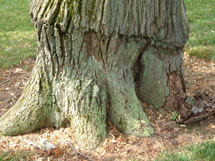 Graft union incompatibility on linden showing that the budded top did not develop a complete connection with the root stock. |

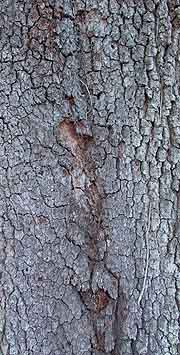
 Natural
cracks such as this one (in the center of the photo) on the lower trunk
of laurel oak are normal for some trees. These can be the cause of failures
later, or they may cause no problems. However, cracks
under branches could create dangerous conditions.
Natural
cracks such as this one (in the center of the photo) on the lower trunk
of laurel oak are normal for some trees. These can be the cause of failures
later, or they may cause no problems. However, cracks
under branches could create dangerous conditions.